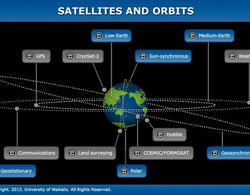A geosynchronous orbit (GEO) matches the Earth’s rotation.
Advantage: satellite stays in place over a single longitude but can move above or below the equator, which provides different angles for observation/communication
Altitude: 42,164 km
Satellite period: 23 hours 56 minutes 4 seconds
Satellite examples: communications satellites
Transcript
Dr Allan McInnes
If we’re in a geosynchronous orbit, meaning that we have a 24 hour orbit period, what’s going to happen is, if you think of being an observer on the ground looking up at that satellite, the satellite starts off directly overhead and it’s rotating at the same rate that the Earth’s rotating, then it’s going to always look like it’s directly overhead. Or from the satellite’s perspective, if you’re looking down trying to observe the Earth or communicate to somebody on the ground, the satellite is going to appear as if it’s directly over one point on the Earth and we’ll always see that point.
Now a geosynchronous orbit is one that happens to have a 24-hour orbital period, which means that it’s rotating at the same rate as the Earth but there’s no guarantee that you’re going to hang over one spot. If the angle of the orbit is tipped relative to the equator, if it’s an inclined orbit, what will happen is it will stay over one line of longitude.


